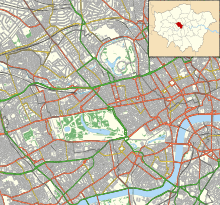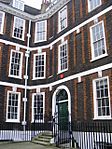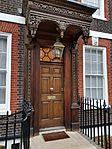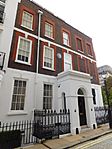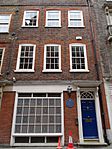Queen Anne's Gate facts for kids
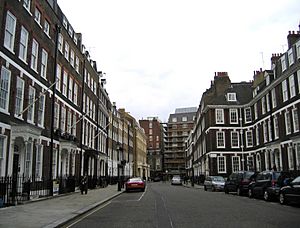
“the best of their kind in London”
|
|
| Former name(s) | Queen Square, Park Street |
|---|---|
| Maintained by | Transport for London |
| Location | Westminster, London |
| Postal code | SW1 |
| Nearest Tube station |
|
| Coordinates | 51°30′02″N 0°07′56″W / 51.5005°N 0.1322°W |
| East end | Storey's Gate |
| West end | Petty France |
Queen Anne’s Gate is a famous street in Westminster, London. Many of its buildings are very old and special. They are known for their beautiful Queen Anne style architecture. Experts have called these houses "the best of their kind in London."
Because the street is close to the Palace of Westminster (where the UK Parliament meets), many important politicians lived here. For example, Lord Palmerston, who later became Prime Minister, was born at No. 20. Other famous people like the thinker John Stuart Mill and the founder of MI6 (Britain's secret intelligence service), Mansfield Smith-Cumming, also lived on this street.
Contents
Where is Queen Anne's Gate?
Queen Anne’s Gate is located in the heart of London. It starts at Old Queen Street in the east. It ends in a quiet street (called a cul-de-sac) in the west. The street runs next to Birdcage Walk to the north. To the south, you'll find streets like Petty France. Another street called Carteret Street also connects to Queen Anne’s Gate.
A Look Back: History of the Street
Queen Anne's Gate wasn't always one street. It was once two separate streets. The eastern part was called Park Street. The western part was known as Queen Square.
Until 1873, a wall divided these two streets. A special statue of Queen Anne was placed within this wall. In 1874, the wall was taken down. Park Street and Queen Square were then joined together. They were renamed Queen Anne's Gate. All the houses were given new numbers.
Old Buildings and Special Styles
The street has amazing examples of Queen Anne and Georgian style houses. These are called townhouses. The oldest buildings are at the western end. Many of them were built around 1704-1705.
A special thing about these old houses is their fancy doorcases. These are the decorated frames around the doors. They often have detailed carvings of plants and faces. Experts say the houses on Queen Anne's Gate are "the best of their kind in London."
The Queen Anne Statue
The statue of Queen Anne is very old. It was made when Queen Anne was alive. It is carved from a type of stone called Portland stone. No one knows for sure who sculpted it. This statue is so important that it has a special protection called a Grade I listing. This means it's a very important historical item.
From Chapel to Offices
At No. 50 Queen Anne's Gate, there was once a chapel. It was built in 1706 for the people living in Queen Square. Over time, it changed uses many times. By 1870, it became a school for poor children. Later, it was a mission hall and a police institute. By 1890, it was used as offices. Today, a modern building for the Ministry of Justice stands on that spot.
Houses Becoming Offices and Back Again
Originally, most buildings on Queen Anne’s Gate were homes. By the late 1900s, many were turned into offices. But in the 21st century, this trend changed. Many buildings are now being turned back into private homes.
Famous Residents and Special Buildings
Queen Anne’s Gate has been home to many important people. Because it's so close to the Palace of Westminster, many politicians chose to live here. Some houses have special Blue plaques. These blue circles on the wall tell you that a famous person once lived there.
Many of the buildings are listed buildings. This means they are protected because they are historically or architecturally important. Most are Grade I listed, which is the highest level of protection.
- No. 3: This house was home to Edward Grey, 1st Viscount Grey of Fallodon. He was a very important politician. He was the Foreign Secretary when the First World War began.
- No. 15: This house has special designs inside by a famous architect named Edwin Lutyens.
- No. 16: This house was home to John Fisher, 1st Baron Fisher. He was a top naval officer who helped modernize the British navy. It was also home to William Smith, who worked to end slavery. Both have blue plaques here.
- No. 19: William Paterson, one of the people who helped start the Bank of England, lived here. Later, Aston Webb, an architect who redesigned Buckingham Palace, lived in this house.
- No. 20: This is where Lord Palmerston was born. He later became the Prime Minister of the United Kingdom.
- No. 21: This house was once home to Sir Mansfield Smith-Cumming. He was the first head of MI6, Britain's secret intelligence service. It's even rumored that a secret tunnel led from this house to MI6's main office nearby!
- No. 26: The famous musician Sting and his wife Trudie Styler lived here for about 20 years.
- No. 28: In the early 1900s, this was the home of Richard Haldane, 1st Viscount Haldane. He was a politician who made big changes to the army.
- No. 40: This house was home to the famous philosopher John Stuart Mill and his father.
Old Queen Street
Old Queen Street is like a continuation of Queen Anne’s Gate. It connects to Storey’s Gate. This street was first built with townhouses in the late 1700s. Seven of the buildings on Old Queen Street are also listed as historically important.
Gallery


